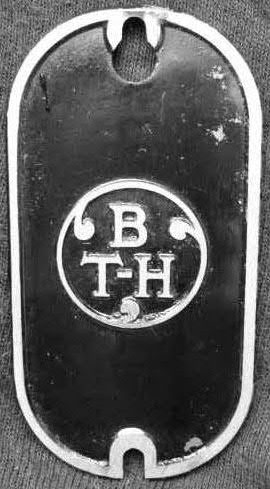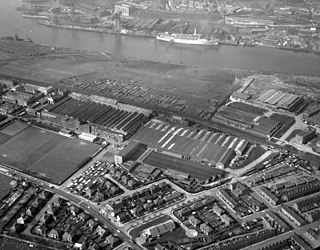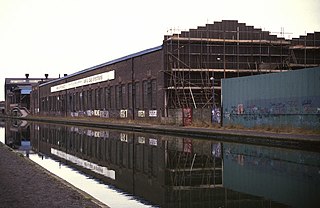
Tyne and Wear is a ceremonial county in North East England. It borders Northumberland to the north and County Durham to the south, and the largest settlement is the city of Newcastle upon Tyne.

Rolls-Royce Holdings plc is a British multinational aerospace and defence company incorporated in February 2011. The company owns Rolls-Royce, a business established in 1904 which today designs, manufactures and distributes power systems for aviation and other industries. Rolls-Royce is the world's second-largest maker of aircraft engines and has major businesses in the marine propulsion and energy sectors.

Sir Charles Algernon Parsons, was an English engineer, best known for his invention of the compound steam turbine, and as the eponym of C. A. Parsons and Company. He worked as an engineer on dynamo and turbine design, and power generation, with great influence on the naval and electrical engineering fields. He also developed optical equipment for searchlights and telescopes.

British Thomson-Houston (BTH) was a British engineering and heavy industrial company, based at Rugby, Warwickshire, England. Originally founded to sell products from the Thomson-Houston Electric Company, it soon became a manufacturer using licences from the American company. They were known primarily for their electrical systems and steam turbines.

Turbinia was the first steam turbine-powered steamship. Built as an experimental vessel in 1894, and easily the fastest ship in the world at that time, Turbinia was demonstrated dramatically at the Spithead Navy Review in 1897 and set the standard for the next generation of steamships, the majority of which would be turbine powered. The vessel is currently located at the Discovery Museum in Newcastle upon Tyne, North East England, while her original powerplant is located at the Science Museum in London.

Bruce Peebles & Co. Ltd. was an Edinburgh industrial electrical engineering company.

Ruston & Hornsby was an industrial equipment manufacturer in Lincoln, England founded in 1918. The company is best known as a manufacturer of narrow and standard gauge diesel locomotives and also of steam shovels. Other products included cars, steam locomotives and a range of internal combustion engines, and later gas turbines. It is now a subsidiary of Siemens.

Clayton Equipment Company Ltd, now known simply as Clayton Equipment Ltd or CEC and CEL, is a locomotive construction company that specialises in rail equipment, design and build, tunnelling, mining, metro, mainline and shunter locomotives.
Parsons Marine Steam Turbine Company was a British engineering company based on the River Tyne at Wallsend, North East England.

A. Reyrolle & Company was a British engineering firm based in Hebburn, Tyne and Wear in the North East of England. For many years the company was one of the largest employers on Tyneside.

Clarke Chapman is a British engineering firm based in Gateshead, which was formerly listed on the London Stock Exchange.

Northern Engineering Industries plc (NEI) was a British engineering firm, which for over 10 years was one of the largest employers on Tyneside. Its headquarters were based at the Regent Centre at Gosforth in Newcastle upon Tyne.

Forth Banks Power Station was a coal-fired power station in North East England. It was situated in the city centre of Newcastle upon Tyne on Forth Banks, a street to the rear of Newcastle Central station. Put up in a disused factory building in 1890 by the Newcastle and District Electric Lighting Company (DisCo), it is notable as the first power station in the world to use turbo alternators, as well as being one of the first municipal power stations in the United Kingdom.

The Newcastle and District Electric Lighting Company was a pre-nationalisation, private electricity supply company, based in Newcastle upon Tyne in North East England. The company was set up in 1889 by Charles Algernon Parsons. The company built a number of small coal-fired power stations in the west end of Newcastle upon Tyne, initially to supply homes and streets with electric lighting. They also provided power for an electrified tram line in the western part of the city.
Centrax, also known as Centrax Limited is an engineering company based in Newton Abbot, Devon in the power generation industry making generating sets with Siemens gas turbine engines. These are known as industrial gas turbines.
Joseph Booth & Bros was an English company notable for making cranes used in large construction projects.

Belliss and Morcom is a manufacturer and supplier of oil-free reciprocating compressors, technologies and services. Founded in 1852 in Birmingham, West Midlands, it is now a division of Ingersoll Rand based in Redditch, Worcestershire, England.

Rachel Mary Parsons (1885–1956), was an English engineer and advocate for women's employment rights, was the founding President of the Women's Engineering Society in Britain on 23 June 1919.

Katharine, Lady Parsons was the co-founder and second President of the Women's Engineering Society (WES), and an engineer in her own right.

The Company, initially known as W. H. Allen & Co was founded in 1880 by William Henry Allen as a manufacturer of centrifugal pumps and steam engines in York Street, Lambeth, London. Electric light generating machinery followed with the support of Gisbert Kapp. The firm also supplied marine auxiliary equipment for both the Royal Navy and Mercantile Marine.


















